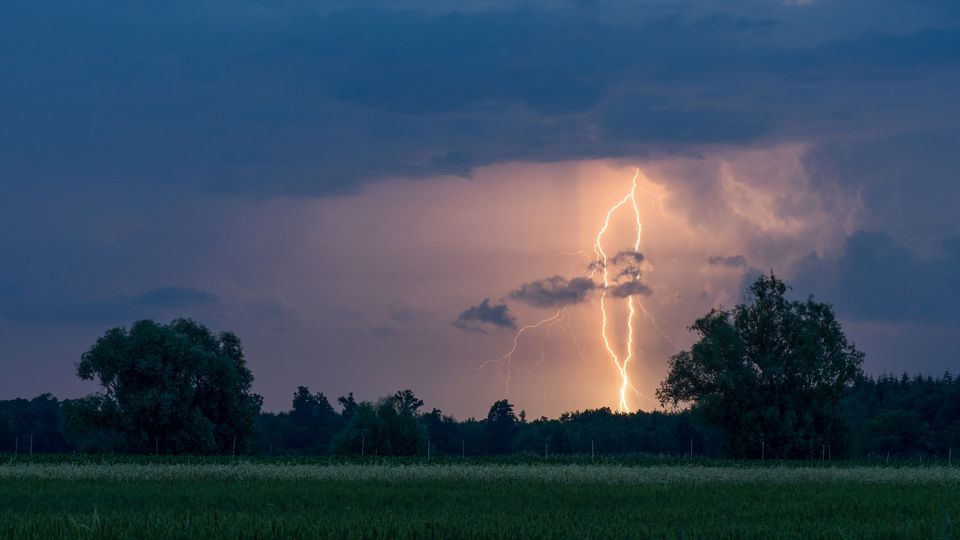Hiking in Thunderstorms: Safety Guide

For all you thrill-seekers out there, hiking in thunderstorms can be an exhilarating experience. For others (including myself), hiking during a thunderstorm can spell trouble and instill fear. So what are you supposed to do when you’re out in the middle of your hike, and thunder starts crashing down like beating drums?
This article will detail what you need to know about thunderstorms and how to stay safe while hiking during one.
Quick Links
What to Do if It Storms While Hiking?
If you hear thunder, that means that lightning is not too far behind. When hiking in a thunderstorm, your first priority should be to get to safety as quickly as possible. If you can make it to a building or car, do so. Otherwise, find the lowest point in the area and crouch down, making yourself as small a target as possible. Here are a few other tips to keep in mind:
- Avoid open spaces, hilltops, metal objects, and bodies of water.
- Stay away from trees—if lightning hits a tree, the electrical current can travel through the ground and injure you.
- Do not lie flat on the ground, as this will make you more susceptible to being struck by lightning. Instead of laying flat on the ground, curl up in a ball and make as little contact with the ground as possible.
- If you are in a group, spread out to minimize the chances of everyone being hit if lightning does strike.
- Insulate yourself from the ground by sitting on your pack or using a sleeping pad.
- Wait out the storm in this position until it passes. Once the thunder has stopped, you can continue on your hike.
What to Do if Someone is Struck by Lightning?
If someone in your group is struck by lightning, it is important to act quickly. Call 911 if possible (The unfortunate reality is that you probably won’t have much cell phone service) and then follow these steps:
- Check for a pulse and breathing. If the person has a pulse and is breathing, they are in cardiac arrest and will need CPR. If they are not breathing, begin rescue breaths.
- If the person is not breathing and does not have a pulse, they will need CPR.
- Perform CPR for two minutes before checking for a pulse again. If there is still no pulse, continue CPR.
- If the person begins breathing on their own, monitor them closely and be prepared to perform CPR again if necessary.
I know what you’re thinking, CPR to a person who’s been struck by lightning? Won’t that just electrocute you or them further? People who have been struck by lightning do not carry an electrical charge. So it is completely safe to perform CPR on them.
Another option is to carry and use a personal locator beacon. Personal locator beacons send out a distress signal that can be picked up by satellite. So if you ever find yourself in an emergency situation with no cell reception, these can be a lifesaver.
I know it’s a terrible situation to think about, but the reality is that thunderstorms can and do strike while people are hiking. Hopefully, you’ll never be in this situation, but it’s always best to be prepared.
Are You Safe in The Woods During a Thunderstorm?
I was always told when I was young and playing in the rain to avoid trees during a thunderstorm. I was told that trees attract lightning, and there was a much greater chance of being struck if I was underneath one.
So here’s the exact science and reasoning behind this: Lightning typically strikes the tallest objects. When you’re out in the woods – that’s gonna be the trees. But trees are not good conductors of electricity. So what happens is lightning currents pass through trees and into the roots and trunk, and then dissipate into the ground.
However, WE are much better conductors of electricity than trees are. So if you’re close enough to the tree when this happens – like within 10 feet – the current can pass through the ground and shock you. You aren’t just in danger from a direct hit; it’s the electrical current that you also have to worry about.
That’s another reason NOT to lay flat on the ground. The current travels from the ground, so you want to make as little contact with the ground as possible.
What Do You Do if You Are Caught in A Thunderstorm While Hiking?
If you are caught in a thunderstorm while hiking, you’re going to need to act quickly. Here are some tips on what to do if you find yourself in this situation:
- First and foremost, try to get off of any exposed peaks or ridges. If you can’t get off the peak, then crouch down as low to the ground.
- As I mentioned before, avoid being near tall objects like trees. If you can’t avoid trees, then stay away from the trunks and keep your feet together.
- If you are in a group, spread out to minimize the chances of everyone being hit if lightning does strike.
- Insulate yourself from the ground. Use a backpack, sleeping pad, or anything else that will help to keep you dry and away from the ground.
- Don’t touch anything metal. This includes things like hiking poles, backpacks with metal frames, etc.
- If you hear thunder, you are close enough to be struck by lightning. And if you can see lightning, then you are close enough to hear thunder. So basically, if you can see or hear either one, then get to a safe location as quickly as possible.
- Once you’re in a safe location, stay there for 30 minutes after the last sound of thunder or the sight of lightning.
Thunderstorm Hiking Prevention Tips
The best way to deal with a thunderstorm is to avoid it altogether. Here are some tips on how to do that:
- Check the weather forecast before you go out hiking. If there is a chance of thunderstorms, then consider postponing your hike or choosing a different trail.
- Sometimes the weather can be completely unpredictable. The forecast could call for clear skies, and all of a sudden, a thunderstorm pops up. So always be aware of your surroundings and have a plan B in mind if the weather turns for the worse. Pack like you were going hiking during a rainstorm.
- Be aware of the signs that a thunderstorm is approaching. These can include darkening skies, increasing wind, or a drop in temperature.
- If you see or hear a thunderstorm, head to lower ground immediately.
- Another option is to carry and use a personal locator beacon. Personal locator beacons send out a distress signal that can be picked up by satellites. This can be helpful if you do find yourself in a situation where you need to be rescued.
Thunderstorms can be dangerous, but if you know what to do and how to avoid them, you’ll stay safer on your hikes.
Why Is There More Lightning In The Mountains?
There is more lightning in the mountains because storms tend to develop more quickly there. The mountain air is also generally cooler, which can contribute to thunderstorm development. Additionally, the terrain in the mountains provides natural conduits for electrical currents, making it easier for a lightning strike to occur.
Secondly, there’s another risk to being high up in the mountains beside having to deal with higher lightning. There’s something called a “tree line,” which is the boundary between where trees can grow and where they can’t. There are fewer trees as you go up in altitude because the air gets thinner and colder, and there’s less oxygen.
So not only do you have to worry about being struck by lightning, but now there are no more trees. So all of a sudden, you become the tallest object on the mountain.
And as we’ve talked about before, the tallest objects are more likely to be struck by lightning. So if you’re above the tree line, then you need to be extra careful & mindful during a thunderstorm.
Conclusion
Thunderstorms are natural, beautiful phenomena but can also be very dangerous. If you know what to do and how to avoid them, you’ll stay safe on your hikes. Be sure to check the weather forecast before heading out, and always be aware of your surroundings. If you see or hear a thunderstorm approaching, head to lower ground immediately. And finally, if you find yourself in a situation where you need to be rescued, consider carrying and using a personal locator beacon.
My best advice; if the weather looks terrible, just skip the hike. There’s always another day to explore. Stay safe!






